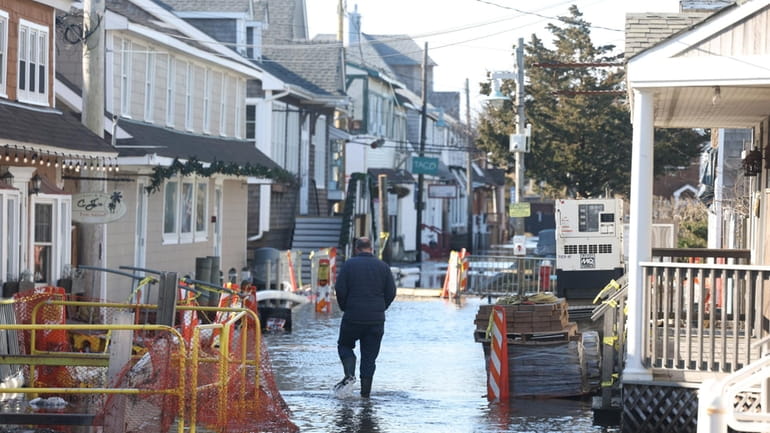January storm created overwashes, National Park Service says, contradicting early Suffolk assessment

Ocean Beach in Fire Island is flooded after a January storm. Credit: James Carbone
National Park Service officials said Friday a winter storm last month did not cause breaches on Fire Island, contrary to what Suffolk County officials said at the time.
The park service said in a news release the storms caused “a number of overwashes” on the barrier island, adding “there were no confirmed breaches on Fire Island.”
The agency did not give a precise number of overwashes or indicate where they were located.
County officials, when asked about the park service statement, said Friday the breaches were noted as part of an initial assessment of damage taken after the January storm. They referred questions to state officials.
A state spokesman said Fire Island is at risk of damage "regardless of the technical nuance of the types of impacts," adding state officials would "advance needed actions to secure" the island against future storms.
After assessing damage from a powerful coastal storm early last month, Suffolk officials on Jan. 11 said the weather system had created two breaches on the island — one at Robbins Rest and one in Fire Island Pines.
But the park service Friday issued a three-page news release saying no breaches occurred. The release included detailed definitions of breaches and overwashes, and included photographs to illustrate the differences.
Nick Clemons, chief of interpretation for the Fire Island National Seashore, a division of the park service, said park service officials reached their conclusion using criteria set by the U.S. Army Corps of Engineers. Park service staff were able to travel east to Fire Island Pines without being impeded by water flow between the Atlantic Ocean and Great South Bay, he said.
“Water from the extreme storms did go over the dunes," Clemons said in an interview. "But it was not a prolonged event that cut all the way over to the bay side.”
He added: “People use the terms breach and overwash so interchangeably, when it is actually two separate events.”
The park service release defined a breach as a "condition where a channel across the island is formed that permits the exchange of ocean and bay waters under normal tidal conditions." Breaches may be temporary or permanent, the statement said, adding that breaches may vary because of their size and factors such as bay water depths and wave conditions following the storm.
Overwashes are a common occurrence during major storms, the statement said, adding overwashes typically run no farther than dune lines but sometimes cross over barrier islands into bays, but cause no permanent damage.
The distinction is important to marine scientists, who say that breaches, which may last months or years before they close naturally, can reinvigorate stagnant water bodies such as bays and ponds.
State officials have said they would release $3 million to pump sand on eroded beaches at Fire Island, and Brookhaven officials are spending up to $500,000 to place sandbags at eastern Fire Island communities such as Davis Park and Seaview.
A Fire Island breach caused by Superstorm Sandy in 2012 replenished Bellport Bay with fresh ocean water, helping efforts to restore shellfish populations, scientists said. That conclusion has been questioned by detractors such as fishermen who said they saw no change in water quality.
The breach, or inlet, has since closed on its own, Newsday has reported.
With Brianne Ledda

